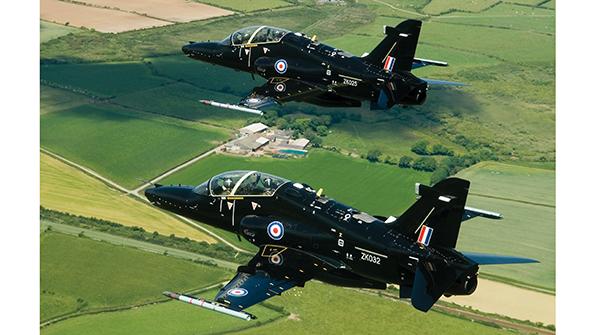
The Eurofighter’s recent renaissance and future evolution plans are a positive step for Europe’s ambitions to build future combat aircraft, but fast decision-making by the partner nations is needed, says the managing director of BAE Systems’ air business Chris Boardman.
The European fighter, jointly developed by Germany, Italy, Spain and the UK, is enjoying something of a renaissance—with orders from Kuwait and Qatar as well as the potential of top-up buys from Germany and Spain that could push production of the fighter out to the mid-2020s and later. But finalizing how the aircraft should evolve is still the subject of extensive debate.
- Eurofighter nations moving toward Long-Term Evolution plan
- Second Saudi Typhoon order is likely Tornado replacement
“The bit we are trying to get to a conclusion is the Long-Term Evolution [LTE] of Typhoon,” Boardman tells Aviation Week.
“The four nations are having debates about the requirements,” he says. “They will not all be the same . . . but they need to be harmonized.”
Approvals need to be granted by all four partner nations before the LTE initiative, revealed at last year’s Paris Air Show, can move ahead. The LTE plan is essentially a midlife update for the fighter, one that will bring it into the Information Age and serve as a steppingstone toward the European Future Combat Air System and part of the UK’s Tempest initiative and Combat Air Strategy. In the UK, Boardman said there is a “near-term focus” on concluding commitments for Radar 2, a derivative of the Euroradar Captor-E active, electronically scanned array (AESA) radar planned for UK aircraft. Radar 2 will feature an electronic attack capability, but Boardman suggested that decision-making process was being impacted by the novel coronavirus pandemic. As a result, he is urging governments to make decisions more expeditiously. “From an industrial point of view, we need to be quicker on that issue,” Boardman said.
Boardman is encouraged, however, by Germany’s decision to adopt the Mk. 1 AESA radar for Tranche 2 and 3 models of the aircraft. But he notes that the radar programs have to be “carefully managed,” as there are now essentially three different radars in the Eurofighter program.
“I am happy that the German nation has made a commitment,” he says. “We hope it lays the groundwork for more Eurofighters into the Luftwaffe.”
It could also bolster export campaigns. BAE, which has a 33% share in the Eurofighter consortium, has been the most successful of the industrial partners in achieving export sales of the fighter—collaborating with the UK government to sell aircraft to Oman, Qatar and Saudi Arabia. The UK is also leading the campaign in Finland.
BAE remains hopeful of securing a follow-up Eurofighter order from Saudi Arabia. Riyadh signed a memorandum of intent in March 2018 to purchase an additional 48 Eurofighters to join its fleet of 72 aircraft. Nevertheless, licensing issues as a result of a German prohibition of arms sales to Saudi Arabia and the halting of new UK export licenses for defense equipment to the kingdom has challenged progress. The British government announced in July that it would restart arms exports to Riyadh.
“We are not in a sales mode with Saudi Arabia” Boardman says. “If you look at the Saudi air force and the decisions it has to make, it needs to replace its [Panavia] Tornadoes at an appropriate time.
“The aircraft is the centerpiece of the Royal Saudi Air Force,” he suggests. “It’s been utilized well and heavily, so let’s not try and sell it. Let it sell itself.”
While the future of the Eurofighter looks bright, less certain is the future of BAE’s highly successful Hawk jet trainer.
Although the type has been buoyed by orders from the Middle East in recent years, including a batch being assembled in Saudi Arabia, orders look set to dry up once nine aircraft for Qatar are completed.
“We put a lot of effort in trying to get continuity,” Boardman explains, noting recent efforts to sell new-build aircraft to Kuwait were unsuccessful.
“Restarting [production] lines is costly,” Boardman says. “There are lots of people in the world who are trying to sell the training aircraft—having invested heavily in them—so it is whether you can be competitive in that situation.” Boardman does not rule out the possibility that a sizable order could enable Hawk production to resume, but he says it would be a challenge to be competitive.
A future jet trainer is not ruled out: Some level of live flying will still be needed by future fast-jet pilots, despite advancements in synthetics.
“Will there be training aircraft needed in the world going forward?” Boardman asks rhetorically, noting that the U.S. Air Force is pursuing the development of the T-X platform, and the U.S. Navy is beginning to look at a replacement for the T-45 Goshawk, derived from BAE’s Hawk. “Certainly, yes, but what level and what volume? That is the fundamental question,” he adds.
Despite what Boardman describes as some “hiccups” in component production for the F-35 because of the COVID-19 crisis, the situation has now “stabilized,” and the company is working toward its 2020 operational plan.
